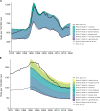Racial disparities in prostate cancer mortality: a model-based decomposition of contributing factors
- PMID: 37947332
- PMCID: PMC10637024
- DOI: 10.1093/jncimonographs/lgad018
Racial disparities in prostate cancer mortality: a model-based decomposition of contributing factors
Abstract
To investigate the relative contributions of natural history and clinical interventions to racial disparities in prostate cancer mortality in the United States, we extended a model that was previously calibrated to Surveillance, Epidemiology, and End Results (SEER) incidence rates for the general population and for Black men. The extended model integrated SEER data on curative treatment frequencies and cancer-specific survival. Starting with the model for all men, we replaced up to 9 components with corresponding components for Black men, projecting age-standardized mortality rates for ages 40-84 years at each step. Based on projections in 2019, the increased frequency of developing disease, more aggressive tumor features, and worse cancer-specific survival in Black men diagnosed at local-regional and distant stages explained 38%, 34%, 22%, and 8% of the modeled disparity in mortality. Our results point to intensified screening and improved care in Black men as priority areas to achieve greater equity.
© The Author(s) 2023. Published by Oxford University Press. All rights reserved. For permissions, please email: journals.permissions@oup.com.
Conflict of interest statement
YAN is a scientific advisor for Ortho-Clinical Diagnostic and Immunity Bio Inc. JES served as a key opinion leader for Fortec Medical and received grant support from Bristol Myers Squibb Foundation. The other authors declared no potential conflicts of interest.
Figures

References
-
- National Cancer Institute Surveillance Epidemiology and End Results (SEER) Program. SEER 22 Regs Research Data, Nov 2021 Sub (2000-2019). National Cancer Institute, DCCPS, Surveillance Research Program, Surveillance Systems Branch. http://www.seer.cancer.gov. Published 2022. Accessed June 28, 2022.
Publication types
MeSH terms
Substances
Grants and funding
LinkOut - more resources
Full Text Sources
Medical

